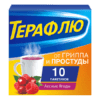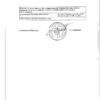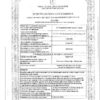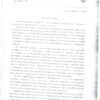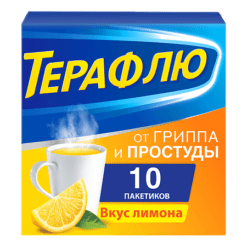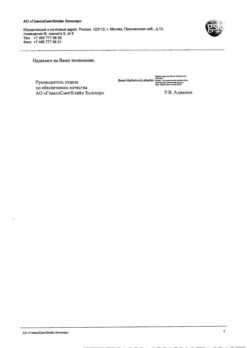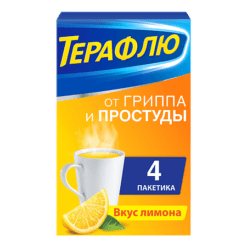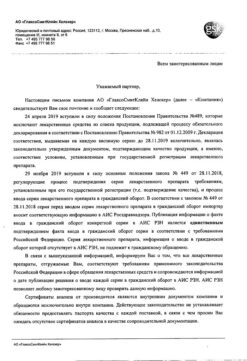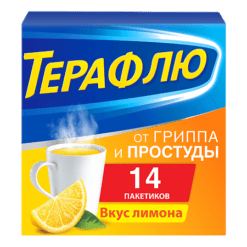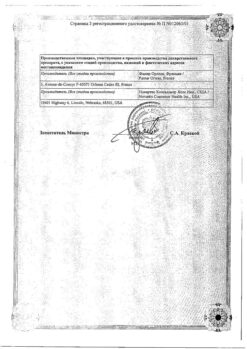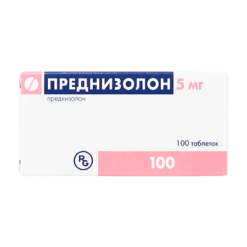No products in the cart.
TeraFlu for flu and cold, 10 pcs.
€14.43 €12.50
Out of stock
(E-mail when Stock is available)
Description
The acute respiratory infections and “cold” symptoms remedy (analgesic non-narcotic + alpha-adrenomimetic + H1-histamine receptor blocker).
ATX code: N02BE51.
PHARMACOLOGICAL PROPERTIES
Combined remedy, the action of which is due to its constituent components, has antipyretic, analgesic, vasoconstrictor effect, eliminates the symptoms of “colds”. It narrows nasal vessels, eliminates the swelling of the nasal cavity mucosa and nasopharynx.
Pharmacodynamics
Paracetamol
Paracetamol has an analgesic and antipyretic effect by inhibiting the synthesis of prostaglandins mainly in the central nervous system. It does not affect platelet function and homeostasis.
Pheniramine maleate
Pheniramine maleate is an anti-allergic agent – blocker of H1-histamine receptors and leads to relief of common allergic symptoms associated with respiratory disorders. It has a moderate sedative effect and also exhibits antimuscarinic activity.
Phenylephrine hydrochloride
Phenylephrine is a sympathomimetic agent and when taken orally has a moderate vasoconstrictor effect (due to stimulation of alpha1 adrenoreceptors), reduces swelling and hyperemia of the nasal mucosa.
Pharmacodynamic effects
Paracetamol
The lack of inhibition of peripheral prostaglandin synthesis gives the drug significant pharmacological properties, such as the preservation of protective prostaglandins in the gastrointestinal tract. Therefore, paracetamol is particularly suitable for patients who have a history of disease or who concomitantly receive medications in which inhibition of peripheral prostaglandin synthesis would be undesirable (e.g., patients with a history of gastrointestinal bleeding or elderly patients).
Phenylephrine hydrochloride
Phenylephrine hydrochloride has anti-inflammatory activity and reduces nasal mucosal edema and swelling.
Pharmacokinetics
Paracetamol
Paracetamol is quickly and almost completely absorbed from the gastrointestinal tract. After oral administration the maximum concentration of paracetamol in plasma is reached after 10-60 minutes. Paracetamol is distributed in most body tissues, penetrates through the placenta and is present in breast milk. At therapeutic concentrations, binding to plasma proteins is insignificant, increasing with increasing concentrations. It is subjected to primary metabolism in the liver and is mainly excreted in the urine as glucuronide and sulfate compounds. Less than 5% of the taken dose is excreted as unchanged paracetamol. The elimination half-life is 1-3 hours.
Pheniramine maleate
The maximum concentration of pheniramine in plasma is reached after about 1-2.5 hours. The half-life of pheniramine is 16-19 hours. 70-83% of the taken dose is excreted with urine as metabolites or unchanged.
Phenylephrine hydrochloride
Phenylephrine hydrochloride is unevenly absorbed from the gastrointestinal tract and undergoes presystemic metabolism by monoamine oxidases in the gut and liver. Thus, phenylephrine hydrochloride has reduced bioavailability when taken orally. It is excreted with the urine almost completely as sulfate compounds. Maximum plasma concentrations are reached between 45 minutes and 2 hours. The elimination half-life is 2-3 hours.
Indications
Indications
Active ingredient
Active ingredient
Composition
Composition
Active ingredients
Paracetamol 325.0 mg
Pheniramine maleate 20.0 mg
Phenylephrine hydrochloride 10.0 mgbr>Phenylephrine hydrochloride 10,0 mg
Ancillary Ingredients
Saccharose 10,000.0 mg
Acesulfame potassium 13.0 mg
Dye red charming E129 (dye FD&C red #40) 2,400 mg
Dye diamond blue E133 (dye FD&C blue #1)Amp;C blue # 1) 0,300 mg
Maltodextrin M 100 26,0 mg
Silica 13,0 mg
Raspberry flavoring natural WONF Durarome (860385 TD0994) 165,0 mg
Cranberry flavoring natural Durarome (861149 TD2590) 55,0 mg
Citric acid 7,0 mg
Cinnamon flavoring natural WONFbr> Citric acid 725.0 mg
Sodium citrate dihydrate 180.0 mg
Calcium phosphate 35.0 mg
Magnesium stearate 3.2 mg
Theoretical weight of the contents of the bag 11572.9 mg
How to take, the dosage
How to take, the dosage
Ingestion. Do not exceed the recommended dose. Use the lowest dose necessary to achieve an effect for the shortest possible duration of treatment.
Adults (including elderly) and children 12 years and older
Packet every 4-6 hours, as needed, but no more than 4 doses in 24 hours. One sachet dissolved in a glass of hot, but not boiling water. It is taken in a hot form. TeraFlu can be used at any time of day, but the best effect brings the drug before bedtime, at night. If there is no relief of symptoms within 3 days after the start of the drug, you should consult a doctor. Patients should not take TheraFlu for more than 5 days.
Special patient groups
Hepatic impairment:
Patients with impaired liver function or Gilbert syndrome should reduce the dose or increase the interval between doses of TeraFlu.
Renal failure:
In the presence of acute renal failure (creatinine clearance < 10 ml/min), the interval between doses of TeraFlu should be at least 8 hours.
Elderly patients:
There is no need to adjust the dose in elderly patients.
Interaction
Interaction
Effects of paracetamol
It enhances the effects of MAO inhibitors, sedatives, ethanol. The risk of hepatotoxic effects of paracetamol increases with concomitant administration of barbiturates, phenytoin, phenobarbital, carbamazepine, rifampicin, isoniazid, zidovudine and other inducers of microsomal liver enzymes. The anticoagulant properties of warfarin and other coumarins may be enhanced with long-term regular use of paracetamol, increasing the risk of bleeding. Single administration of paracetamol has no such effect. Metoclopramide increases the rate of absorption of paracetamol and increases the level of plasma concentration of paracetamol to a maximum. Similarly, domperidone may increase the absorption rate of paracetamol. When using chloramphenicol and paracetamol together, the elimination half-life of chloramphenicol may be increased. Paracetamol may decrease the bioavailability of lamotrigine, with possible reduction of its action due to the indication of its hepatic metabolism. Absorption of paracetamol may be reduced when concomitantly taken with colestyramine, but this can be avoided by taking colestyramine one hour later than paracetamol. Regular use of paracetamol concomitantly with zidovudine may cause neutropenia and increase the risk of liver damage. Probenecid affects the metabolism of paracetamol. In patients taking probenecid simultaneously, the dose of paracetamol should be reduced. Hepatotoxicity of paracetamol may increase with chronic or excessive alcohol consumption. Paracetamol may affect the results of a uric acid test using a phosphotungstate precipitating reagent.
Influence of pheniramine
The effects of other substances on the central nervous system (e.g., MAO inhibitors, tricyclic antidepressants, alcohol, antiparkinsonian drugs, barbiturates, benzodiazepines, tranquilizers and narcotic drugs) may be increased. Pheniramine may inhibit the effect of anticoagulants. Pheniramine has anticholinergic activity and may potentiate the anticholinergic effects of other drugs (other antihistamines, Parkinson’s disease drugs and phenothiazine neuroleptics).
Effects of phenylephrine
TheraFlu is contraindicated in patients who are taking or have taken MAOIs within the last two weeks. Phenylephrine may potentiate the effects of MAO inhibitors and cause an increase in blood pressure. Concomitant use of phenylephrine with other sympathomimetic amines (e.g., decongestants appetite suppressants and amphetamine-like drugs) or tricyclic antidepressants (e.g., amitriptyline) may increase the risk of cardiovascular side effects. Phenylephrine may decrease the effectiveness of beta-adrenoblockers and other antihypertensive drugs (e.g., debrisolin, guanethidine, reserpine, methyldopa). The risk of increased blood pressure and other cardiovascular side effects may be increased. Concomitant use of phenylephrine with digoxin and cardiac glycosides may increase the risk of arrhythmia or myocardial infarction. Concomitant use of phenylephrine with ergot alkaloids (ergotamine and methysergide) may increase the risk of ergotism.
Special Instructions
Special Instructions
In order to avoid toxic liver damage, the drug should not be combined with the use of alcoholic beverages. Contains paracetamol, do not use with any other drugs containing paracetamol. Concomitant use with other drugs containing paracetamol may lead to overdose. Paracetamol overdose may cause liver failure, which may lead to liver transplantation or death. Cases of liver function impairment/hepatic failure have been reported in patients with reduced glutathione levels, such as extremely emaciated patients with anorexia, low body mass index, patients with severe chronic alcohol dependence or sepsis. Concomitant administration with decongestants and antihistamines should be avoided. Patients with the following disorders should consult a physician before taking this drug:
Must be used with caution in elderly patients, who are more prone to develop adverse effects. Use in elderly patients with confusion should be avoided.
Patients should consult a physician if:
These may be signs of more serious disorders.
1 sachet of TeraFlu contains:
Do not use the product from damaged sachets.
Impact on the ability to operate vehicles, machinery
.TeraFlu may cause drowsiness, dizziness, blurred vision, impaired cognitive function and motor coordination, which may significantly affect the ability to drive vehicles and operate machinery. These undesirable effects may be further exacerbated if alcoholic beverages or other sedatives are taken.
Synopsis
Synopsis
Contraindications
Contraindications
Hypersensitivity to individual drug components, concomitant use of tricyclic antidepressants, beta-adrenoblockers or other sympathomimetic drugs (such as decongestants, appetite suppressants and amphetamine-like drugs), simultaneous or within the previous 2 weeks taking monoamine oxidase inhibitors (MAOIs), portal hypertension, alcoholism, diabetes, glucose/isomaltase deficiency, fructose intolerance, glucose-galactose malabsorption, pregnancy, breastfeeding, children under 12 years of age, severe cardiovascular disease, arterial hypertension, hyperthyroidism, closed-angle glaucoma, pheochromocytoma.
WARNING
.In severe coronary atherosclerosis, cardiovascular disease, acute hepatitis, hemolytic anemia, bronchial asthma, severe liver or kidney disease, prostatic hyperplasia, difficulty urinating due to prostatic hypertrophy, blood diseases, glucose-6-phosphate dehydrogenase deficiency, congenital hyperbilirubinemia (Gilbert, Dubin Johnson and Rotor syndrome), Chronic malnutrition (caloric deficiency) and dehydration, pyloroduodenal obstruction, stenotic gastric and/or duodenal ulcer, epilepsy, simultaneous use of digoxin and cardiac glycosides, ergot alkaloids (e.g., ergotamine and methysergide), and drugs that may adversely affect the liver (barbiturates, phenytoin, phenobarbital, carbamazepine, rifampicin, isoniazid, zidovudine and other inducers of microsomal liver enzymes).
Side effects
Side effects
The undesired reactions presented below are listed according to organ and organ system involvement and frequency of occurrence. The frequency of occurrence is defined as follows:
very common (⥠1/10),
frequent (⥠1/100 and < 1/10),
infrequent (⥠1/1,000 and < 1/100),
rarely(⥠1/10,000 and < 1/1,000),
very rarely (< 1/10,000, including individual cases).
Frequency categories were formed based on post-registration follow-up.
Blood and lymphatic system disorders
Frequency unknown: hemolytic anemia
Immune system disorders
Rarely: Hypersensitivity reactions (rash, shortness of breath, anaphylactic shock), angioedema and skin rash, urticaria, allergic dermatitis.
Frequency unknown: anaphylactic reaction, Stevens-Johnson syndrome, toxic epidermal necrolysis.
Mental disorders
Rarely: increased excitability, sleep disturbance.
Frequency unknown: hallucinations, confusion
Nervous system disorders
Frequently: drowsiness.
Rarely: dizziness, headache.
Frequency unknown: anticholinergic symptoms, impaired coordination of movements, tremor, loss of memory or concentration (more common in elderly patients), balance disorders (more common in elderly patients), dizziness (more common in elderly patients), sedation (more pronounced early in treatment), somnolence (more pronounced early in treatment).
Visual impairment
Rarely: mydriasis, accommodation paresis, intraocular pressure disorder, acute closed-angle glaucoma (most likely to occur in persons with closed-angle glaucoma).
Cardiac disorders
Rarely: tachycardia, palpitations.
Vascular disorders
Rarely: increased blood pressure
Frequency unknown: orthostatic hypotension
Gastrointestinal disorders
Frequently: nausea, vomiting
Rarely: dry mouth, constipation, abdominal pain, diarrhea.
Liver and biliary tract disorders:
Rarely: increased activity of liver enzymes.
Dermal and subcutaneous tissue disorders
Rarely: eczema, rash, pruritus, erythema, purpura,
Rarely: renal and urinary tract disorders
Rarely: Difficulty in urination (most often occurs in patients with bladder outlet obstruction, for example, due to prostatic hypertrophy), dysuria.
General disorders and disorders at the site of administration
Rarely: malaise.
Frequent unknown: mucosal dryness
If any of the effects listed in the instructions worsen, or if you notice any other side effects not listed in the instructions, tell your doctor.
Overdose
Overdose
Treatment
If you exceed the recommended dose, seek medical attention immediately, even if you are feeling well, as there is a risk of delayed serious liver damage. Administration of acetylcysteine intravenously or orally as an antidote, gastric lavage, ingestion of methionine may have a positive effect for at least 48 hours after overdose. Administration of activated charcoal and monitoring of respiration and circulation are recommended. Diazepam may be administered if seizures develop.
Symptoms due to pheniramine and phenylephrine (combined because of the mutual potentiation of the parasympatholytic effect of pheniramine and the sympathomimetic effect of phenylephrine in case of overdose of the drug) Overdose symptoms include drowsiness, which is later joined by restlessness (especially in children), visual disturbances, rash, nausea, vomiting, headache, increased agitation, dizziness, insomnia, circulatory disorders, coma, seizures (especially in children), behavioral changes, increased or decreased blood pressure, bradycardia. In cases of pheniramine overdose, cases of atropine-like “psychosis” have been reported. In severe cases confusion, hallucinations, seizures and arrhythmias may develop. No specific antidote is available. Routine treatment measures, including administration of activated charcoal, saline laxatives, and measures to support cardiac and respiratory function, are necessary. Psychostimulants (methylphenidate) should not be administered because of the risk of seizures. Vasopressor drugs may be used in case of hypotension. In case of increased blood pressure, intravenous administration of alpha-adrenoblockers (e.g., phentolamine) is possible, because phenylephrine is a selective agonist of alpha1-adrenoreceptors, therefore, hypertensive effect in case of phenylephrine overdose should be treated by blocking alpha-adrenoreceptors. Diazepam should be used if seizures develop.
Pregnancy use
Pregnancy use
Pregnancy
Data on the use of this drug in pregnant women are insufficient. There are insufficient data obtained in studies of reproductive toxicity in animals. It is not recommended to use the drug during pregnancy.
Breast-feeding period
The use of the drug during breast-feeding is not recommended.
Paracetamol
Paracetamol is excreted with breast milk, but in clinically insignificant amounts when used in the recommended doses.
Pheniramine
There are no animal studies or clinical data on the use of pheniramine during breastfeeding.
Phenylephrine
Phenylephrine may be excreted with breast milk.
Similarities
Similarities
Additional information
| Shelf life | 2 years. Do not use after the expiration date. |
|---|---|
| Conditions of storage | At a temperature not exceeding 25 ºC. Keep out of reach of children. |
| Manufacturer | GSC Conceiver Health Inc, USA |
| Medication form | Powder for preparation of solution for oral administration |
| Brand | GSC Conceiver Health Inc |
Other forms…
Related products
Buy TeraFlu for flu and cold, 10 pcs. with delivery to USA, UK, Europe and over 120 other countries.





